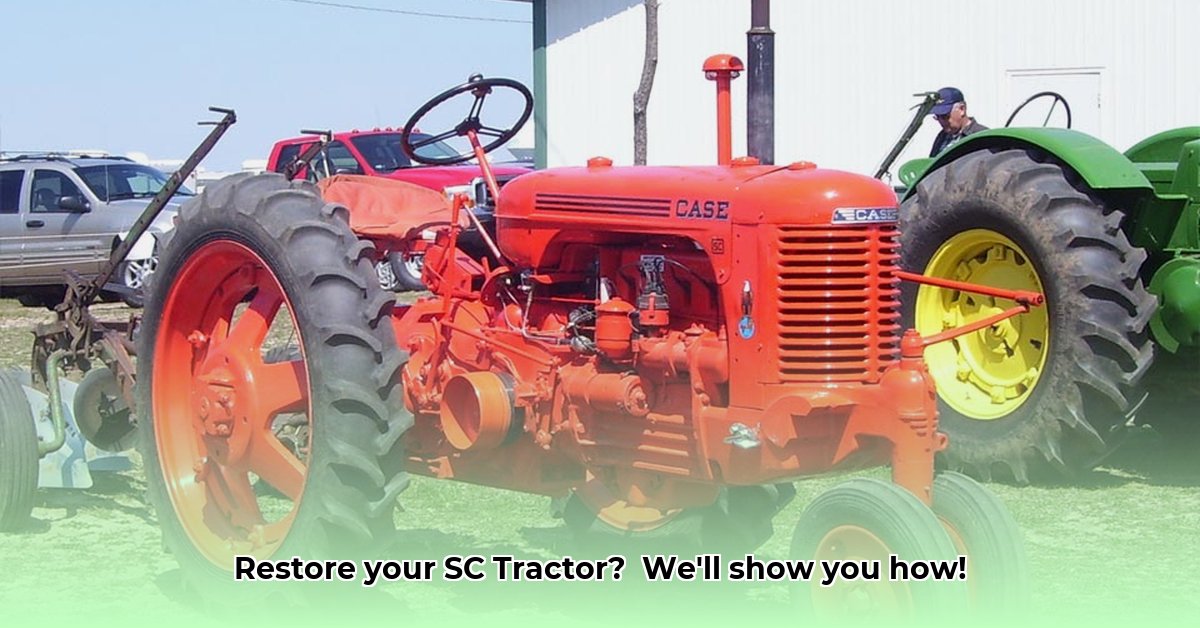
Understanding Your Case SC: A Blast from the Past
Before you even touch a wrench, understanding your Case SC is paramount. Production spanned from 1941 to 1954, with subtle yet significant variations between models. Identifying your tractor's year is crucial for parts sourcing and understanding its original specifications. The serial number, typically found on a plate attached to the tractor, is your primary identifier. Online resources and Case SC enthusiast communities can help decode this number, confirming the exact year and model. This precise identification forms the cornerstone of a successful restoration. For additional Case tractor specifications, check out this helpful resource: Case Tractor Specs.
Finding the Right Parts: A Treasure Hunt
Locating parts for a vintage tractor can feel like a treasure hunt, but effective strategies exist.
Online Marketplaces: Numerous websites specialize in vintage tractor parts; these are excellent starting points.
Online Communities: Connecting with Case SC enthusiasts through online forums and clubs provides invaluable advice, part recommendations, and leads on rare components. The collective knowledge of experienced restorers is an irreplaceable resource.
Junkyards and Salvage Yards: Don't overlook local scrap yards. Sometimes, discarded tractors yield surprisingly usable parts. Thorough searching, especially in well-stocked yards, can be rewarding.
3D Printing: For extremely rare or unavailable parts, 3D printing offers a viable solution, allowing for custom reproduction of components. It's a modern tool invaluable to this vintage restoration work.
Disassembling Your Case SC: A Methodical Approach
Disassembly requires patience and meticulousness.
Photography: Before disassembling any component, take comprehensive photographs from all angles. Your photos serve as your guide during reassembly. Thorough documentation will drastically accelerate the reassembly process and minimize errors.
Organized Disassembly: Employ a systematic approach, using the correct tools for each task. Label and bag each part carefully, and avoid rushing.
Detailed Inventory: As you remove parts, create a detailed inventory, noting their condition (good, damaged, needs repair). Numbering each part improves organization and tracking.
Engine Inspection: Thoroughly inspect the engine for any obvious issues. Major engine work often necessitates professional assistance—consider seeking support from experienced mechanics when needed.
The Restoration Process: Breathing Life Back In
Restoration is a journey, not a race. Each step offers a chance to connect with the machine's history.
Cleaning: Thoroughly clean each part to assess its condition and remove dirt and grime. A clean part is a properly assessed part.
Repair or Replace: Repair what you can, replace what you must. Many parts are available, but some may require creative sourcing (see the "Parts Sourcing" section above).
Reassembly: Utilize your photographic documentation for systematic reassembly, ensuring precision and accuracy.
Testing and Fine Tuning: After reassembly, meticulously test all systems. Regular lubrication is crucial for long-term performance and longevity.
Case SC Tractor Engines: A Deep Dive
Engine type varies depending on your tractor's year.
| Engine Size (liters) | Fuel Type | Approximate Power (HP) | Production Years |
|---|---|---|---|
| 2.5 | Gasoline | 18-20 | 1941-1948 |
| 2.7 | Gasoline or Distillate | 21-23 | 1948-1954 |
Complex engine work should be handled by a qualified mechanic. Don’t risk damaging your restoration through poor engine maintenance.
The Finishing Touches: Paint, Polish, and Pride
The final steps enhance the restoration's aesthetic appeal.
Surface Preparation: Proper surface preparation ensures even paint adhesion and longevity.
Priming: Priming provides an even base for the paint, preventing color inconsistencies.
Paint Matching: Find the correct original paint color for authenticity. Resourcefulness is key, as color shades varied slightly.
Clear Coating: Finish with a clear coat for protection from the elements and long-lasting shine.
Proving Authenticity: Documenting History
Authenticity documentation enhances the tractor's value and heritage.
Serial Number Verification: Cross-reference your tractor's serial number with factory records (if available).
Gathering Documentation: Collect any original sales literature, owner's manuals, or other documents that verify the tractor's history. These records are not only valuable for authentication but also provide compelling historical insight.
Restoring a Case SC is a rewarding challenge. This guide provides a solid framework; remember that each restoration journey is unique. Embrace the process and enjoy the journey! Good luck!